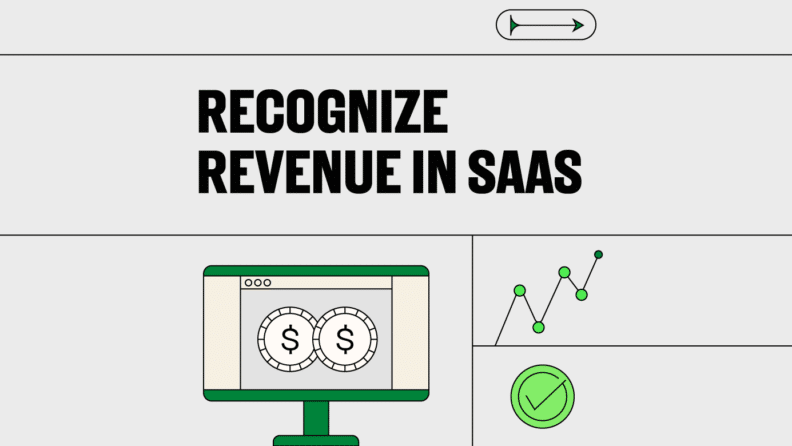SaaS companies need to follow ASC 606. The accounting standard has set a really clear, guiding precedent for SaaS revenue recognition.
For example, SaaS businesses typically collect subscription fees in advance, therefore the question comes up: When should this subscription fee be recognized as revenue on the income statement?
I discuss various concepts related to SaaS revenue recognition in this guide, including deferred revenue and revenue recognition for plan upgrades, downgrades, and cancellations. If you’re a SaaS CFO or part of the accounting team at a SaaS company, this guide is for you.
The Revenue Recognition Principle In SaaS
Revenue recognition is an accounting concept that determines when a business can record sales as revenue on its income statement.
Properly recognizing revenue is vital because MRR and ARR, which depend on the way you recognize revenue, are key SaaS accounting metrics. Investors and other key stakeholders typically aim to maximize MRR and ARR; however, you can only increase these metrics by recognizing revenue; advance payments for services yet to be rendered can’t be added to MRR or ARR.
The concept of revenue recognition originates from accrual accounting. If you follow cash accounting, you recognize revenue whenever you receive cash; however, accrual accounting requires revenue to be recognized when you render the services the customer has paid for (or will pay for).
Suppose today is the last day of the accounting period. A few minutes before the day ends, a customer pays $500 for next year’s annual subscription to your product. Do you add the $500 to your top line in the current year’s income statement?
No.
The revenue recognition standard (ASC 606) states that a business can recognize revenue only once it’s earned. Even though a customer has paid subscription money, you haven’t rendered the service. You can only recognize revenue once the customer uses your product.
If you don’t fulfill your performance obligations, you’ll have to refund a prorated amount to customers, leading to cash flow problems.
Why You Need To Get Recognition Right
Revenue is recognized according to the framework and guidance provided in ASC 606.
The FASB (Financial Accounting Standards Board) and International Accounting Standards Board (IASB) jointly developed ASC 606 (Revenue from Contracts with Customers) to address the revenue recognition requirements of IFRS (International Financial Reporting Standards) and US GAAP (Generally Accepted Accounting Principles).
Creating financial statements in accordance with ASC 606 (or IFRS 15) is critical for compliance. The five-step process outlined in ASC 606 helps ensure you’re compliant with the revenue recognition guidelines.
Revenue Recognition: The 5-Step Process
SaaS companies are subscription businesses. The SaaS business model involves receiving payments on either a usage-based or subscription-based monthly, quarterly, or annual basis.
For the purpose of this guide, I’ll be looking at subscription revenue plans. When your business offers services throughout the subscription period, you might have to recognize revenue on a prorated basis, depending on how frequently your customer is paying.
ASC 606 outlines a five-step revenue recognition process. It’s an industry-agnostic process that helps all companies, SaaS and otherwise, determine when to recognize revenue.
Here are the five steps in the process:
Step 1: Identify the Contract
What conditions should be met when establishing a contract with a customer before you provide access to your SaaS? Revenue is recognized only on valid customer contracts, so it’s important to identify contracts where the customer has agreed to your company’s terms and conditions. The contract may be written, verbal, or implied, as per your policy.
Step 2: Be Clear on Obligations
The contract creates performance obligations for your business. When goods or services are combined with the primary goods or services your business offers, they must be accounted for separately. You can recognize revenue only once you’ve performed your obligations.
Step 3: Calculate Transaction Value
The transaction value is the subscription revenue you expect to receive from a customer for offering your SaaS. For example, if the price of your product is $500 per year, the transaction value for all annual subscription purchase transactions would be $500.
Step 4: Assign Transaction Values
Assigning a transaction value involves outlining the criteria for allocating the transaction price across performance obligations. For example, if you’ve rendered 50% of your obligations, you can recognize 50% of the revenue on your books, regardless of whether the customer has paid in advance or will pay later.
Step 5: Recognize Your Revenue
Revenue can be recognized when you, the entity charging, satisfy a performance obligation. Suppose your performance obligation includes giving your customers access to your product for 12 months (for $500). You can recognize $41.67 at the end of each month, or $125 per quarter, in your accounting software.
Revenue Recognition Concepts
Before going any further, it’s important to understand three key terms:
- Deferred revenue: Deferred revenue (or unearned revenue) is the amount you've billed but not recognized as revenue because you haven’t rendered the service. Deferred revenue appears as a liability on your balance sheet because your business is liable to refund the money to customers if you fail to deliver the service.
- Unbilled revenue: Unbilled revenue is recognized revenue that hasn’t been billed. You might have unbilled revenue on your books when a customer has been using your SaaS, but the billing milestones in your contract only allow billing at a later date (such as the end of the quarter or year). Unbilled revenue is part of accounts receivable on the balance sheet.
- Bookings: Bookings include the value of contracts with a customer for a specific time period. It represents the customer’s commitment to paying you in return for your SaaS. Bookings indicate future revenue growth, which helps estimate future profitability and cash flows.
Common Issues With SaaS Revenue Recognition
Revenue recognition is simple when dealing with annual subscriptions. But what happens when customers cancel their subscription midway or upgrade or downgrade their plan? How do you recognize revenue when your SaaS is bundled with custom features, support fees, or consulting services?
ASC 606 offers guidance on how to account for these. Below, I’ve included some of the most common scenarios you might come across when recognizing SaaS revenue, using the following example:
Suppose you create a $6,000 invoice for XYZ Ltd. in January. Here’s what the revenue schedule would look like:
- End of Q1: $1,500
- End of Q2: $1,500
- End of Q3: $1,500
- End of Q4: $1,500
Revenue Recognition for a Plan Upgrade
XYZ Ltd. upgrades to a higher-tier plan, which costs $9,000 per year, at the end of Q1. By the end of Q1, you’ll have recognized $1,500 in revenue.
When the customer upgrades, you’ll need to issue a credit note worth $4,500:
$4,500 = $6,000 (January invoice amount) - $1,500 (revenue recognized)
The credit note squares off the customer’s account. After you raise a prorated invoice at the end of Q1, your deferred revenue will be $6,750:
$6,750 = [$9,000 subscription fee ÷ 12 months] x 9 months
Starting next quarter, you’d recognize $750 each quarter.
Revenue Recognition for a Plan Downgrade
XYZ Ltd. downgraded to a plan that costs $3,000 per year at the end of Q1. Since you’ll have recognized $1,500 in revenue, you’ll need to issue a credit note worth $4,500 to square off the customer’s account:
$4,500 = $6,000 (invoice amount) - $1,500 (revenue recognized)
After you raise a prorated invoice, your deferred revenue will be $2,250:
$2,250 = [$3,000 subscription fee ÷ 12 months] x 9 months
Starting next quarter, you’d recognize $250 each quarter.
Revenue Recognition in Case of Cancellation
The revenue recognition in case of cancellation depends on your contract terms. Here are the two possibilities:
- Prorated refunds: If your policy is to refund a prorated amount, you can simply credit the amount to the customer’s account. You’d still need to recognize revenue earned before the date of cancellation.
- No refunds: If you have a no-refund policy, you can recognize the deferred revenue on the date of the cancellation. You don’t need to credit the customer’s account since, well, there’s no refund.
Revenue Recognition in Case of Bundled Services
Bundled services create separate performance obligations, so you must separate the revenue from these services and your SaaS. You can recognize revenue from bundled services (such as professional or implementation services) only after you render the service, even if the customer is already using your SaaS.
Suppose you offer implementation services as part of a bundled offering. The client has paid for this service upfront. However, you can recognize this revenue only after the client uses your implementation service. In this case, it’s pretty clear: you just recognize the revenue when the service has been completed.
Revenue Recognition for Add-ons
The revenue from add-ons is recognized when it’s billed. Suppose XYZ Ltd. wants to include the custom development add-on, costing $150, for April and May.
Since XYZ Ltd. wants to use the custom development addon in April and May, that’s when you must recognize the revenue, i.e., $150 in each of April and May.
Revenue Recognition for Bad Debts
When a customer refuses to make the payment after using your service, you must record that uncollectible amount as a bad debt according to GAAP.
For example, suppose XYZ Ltd. has $500 of unbilled revenue. Before you raise an invoice, XYZ Ltd. goes bankrupt, so they can no longer pay the due amount. You’d need to record the $500 outstanding on their account as a bad debt. This is an example of a complete write-off.
If XYZ Ltd. agrees to pay $250, you’d only need to write off $250. This is called a partial write-off.
In either case, a customer’s inability to pay impacts your bookings and, by the same token, your future revenue and net income.
End Of Story
And that’s all there is to it! Due to ASC 606, revenue recognition for SaaS and other tech services has become relatively simple.
Like this article? Subscribe to The CFO Club’s newsletter and receive weekly accounting articles in your inbox.



